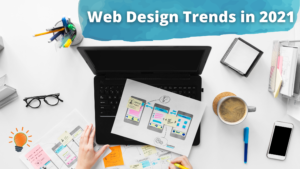
Web Design Trends
Each year’s web design trends promise to beam us into the sci-fi future of our dreams, given that they are based on technology. When it came to designing, we kept an eye on the never-ending trends on the web. But the 2021 predictions we received from our community of web designers from around the world suggest the opposite.
2021’s web design trends appear to share a common theme: rather than aspiring to hi-tech fantasy, web designers are seeking new heights of realism.
Follow along as we share some top web design trends in 2021:
1. Parallax Effects
Parallax is the optical illusion that happens when objects near to the viewer appear to move faster than objects farther away. Although we see this in everyday life—when viewing passing scenery while driving, for instance—the effect on web pages comes across as equal parts real and surreal.
The concept of parallax effects was inspired by the aesthetic of 2D vintage video games. It creates the illusion of depth by using layers moving at different speeds. You can find many methods to design this effect, but it’s often implemented by moving the background slower than the foreground.
2. Emojis
According to Adobe, more than 60 percent of people say emojis make conversations more fun and playful. They are an excellent medium for communicating thoughts and feelings and are widely known as non-verbal messaging.
However, be careful when choosing certain emojis. The same emoji can be interpreted differently in different areas. For example, waving hands means goodbye in the West, but means “we’re not friends” in China.
Putting too many emojis into your messages can also make you look a bit unprofessional and immature.
3. 3D Visuals
Although 2D design still accounts for certain shares, the high application of its 3D counterpart cannot be overlooked.
Three-dimensional images are bringing a tactile element to web design, with drop-shadows, and semi-flat colors, which in turn creates an immersive experience for the viewer. See our best 3D modeling software or animation tools to create your own.
4. Scrolling Transformations
When users scroll, they are doing more than navigating the page: they’re interacting. The physical actions they perform in real life—flicking their fingers over the mouse—cause a response on the screen. Interaction is a form of participation, and when users are involved in things that are happening, they are more likely to be interested and engaged.
5. Multimedia Experiences
With most people having access to faster internet speeds multimedia web experiences are popping up everywhere. Bringing together visuals, text, video, and audio makes for a rich user experience.
Prioritize simplicity, like when combining motion and audio. Too much going on can be distracting or overwhelming to people with cognitive disorders. Include alt text for images, and accompany complex images with longer descriptive text. Avoid autoplaying video or motion content: instead, provide a clear “play” button that affords the user the option to play and pause the content.
6. Dark Mode
Technically speaking, this was a trend that began a couple of years ago on social media, but now we’re really seeing it really comes into its own as designers embrace the dark as a striking backdrop to make images pop. More designers are embracing the dark mode aesthetic, with black providing the perfect dark backdrop to make design elements pop from the screen.
End Words
It’s always exciting to see how web design continues to change, and the continuing momentum of the no-code movement.
If you couldn’t find any idea about what to do to your new or existing website then you can contact Blue 16 Media. We provide quality digital marketing services to complement our web design & other Web Support services including Google Ads, content creation, and more


